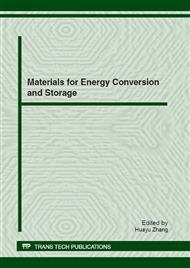p.142
p.147
p.152
p.156
p.160
p.164
p.169
p.174
p.179
Performance Optimization for Lithium–Oxygen Batteries
Abstract:
Lithium–oxygen coin cells without catalyst were assembled in argon atmosphere and tested in pure oxygen. Results showed that the first discharge performance of the batteries was strongly affected by the carbon loading, electrolyte amount and current density. At the carbon loading (0.4 mg/cm2), the electrolyte amount (160 μL/cell) and the current density (0.05 mA/cm2), a high capacity of 4586.5 mAh/g was obtained. The capacity decreased when the carbon loading or current density was increased. And the capacity would have a decrease when the amount of electrolyte was decreased. The highest capacity of 6010.2 mAh/g was obtained by optimizing the combination of carbon loading and electrolyte amount at current density of 0.01mA/cm2. However, the discharge capacity sharply decreased from the second cycle. It may be partly due to the fact that the pores of cathode surface were blocked by discharge products at the end of discharge.
Info:
Periodical:
Pages:
160-163
Citation:
Online since:
July 2012
Authors:
Price:
Сopyright:
© 2012 Trans Tech Publications Ltd. All Rights Reserved
Share:
Citation:


